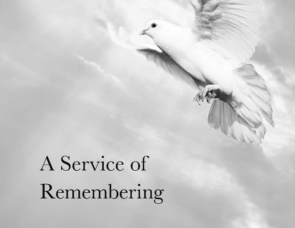To link with the publication of Death and Life: A church’s guide to exploring mortality, former Guidelines editor David Spriggs shares his experience of offering a special ‘Service of remembering’ in his local town and offers some tried-and-tested tips to others who might be thinking of arranging a similar service.

A service of remembering
Covid interrupted many things for churches, one of which was ‘Services of Remembering’. These were an annual opportunity to show support and care for those who had lost loved ones during the previous twelve months or so. Some churches choose ‘All Hallows Eve’ as an appropriate time, but this has rather been taken over by ‘Halloween’ activities.
A mission opportunity as well as a pastoral one?
‘Never mind’, we thought ‘let’s restart this service.’ Previously the small Baptist church where I am at present helping out, had only thought of inviting those people who had been bereaved with links to our church. This time we decided we would seek to extend it to include other churches, so we could show our united face and bring pastoral support to the whole neighbourhood.
We also decided we would approach the local undertakers to see if they would join in such a service.
Finding ‘people of peace’
We recalled the words of Jesus to the 72 disciples:
‘When you enter a house… If a man of peace is there… Stay in that house’ (Luke 10:5–9).
After much prayer and seeking for the right time, but also with a degree of apprehension, I called on Henry Ison & Son, Funeral Directors. Once I had dispelled the thought that I wanted to arrange a funeral, it was clear that I had found my ‘person of peace’. The lady’s face lit up. She explained that she had been sitting there wondering how they could set up such a service. For her, even though I don’t think she is ‘religious’, I was a ‘god-send’.
This new partnership has enabled us to turn a pastoral care event into one that also has a strong missional element. How?
The funeral directors agreed to produce professional literature which included invitation cards, posters and the order of service. This gave the whole event a significant uplift and indicated to all who saw it or who came that they really mattered. Then, perhaps of even greater value, the company agreed to contact all those on their list for funerals in the past twelve months. They also offered to make use of their considerable social media presence to publicise the service and created an arresting window display to catch the attention of passers-by.
Planning together
Over a period of several weeks, we planned, honed and refined the order of service, alerted other local churches and involved other local church leaders.
We distributed the invitation cards and posters to all the nearby churches, along with care homes, sheltered flats, doctors’ surgeries and a support group for the recently bereaved.
Best-loved hymns
For the service, we chose some of the most frequently used funeral hymns at funerals, ensuring that as many people as possible would feel comfortable with these – the service was for them not us!
For the speaker, we were able to enlist a minister who is well-known in the area for taking funerals and services at the crematorium and who enjoyed the confidence of the funeral directors.
We provided a metal tray of tealights so those who wanted could go to the front of the church, light a candle and pause for a moment’s reflection or silent prayer. We also had a ‘quiet table’ with appropriate craft activities in case children came with family.
Payer: a vital ingredient
For us, a vital ingredient in preparation was to get as many people as possible praying for those who had been bereaved, those who would take part in the service, including the staff from the funeral directors, and those who would come.
The test of time!
We were rather surprised that so many people came, probably around 100. We know that of these, over 50 were bereaved. I had wondered whether asking people to go to the front to light a candle would be too much for those who were visitors. But we had to add more tealights to the tray so that everyone who wanted to could light a candle: at least 50 people.
While this was taking place, we had quiet music playing and an image of candles on the screen so everyone could feel involved. It was one of the significant highlights of the service.
We also offered a message card, carefully designed for those who came to the service without faith and helping them gently to see that God’s love holds us all through time and eternity.
After the service, refreshments, kindly provided by the funeral directors, meant that people could mingle, talk, share their journeys through bereavement and relax in a warm environment.
Was it worth it? Various comments, including from one of the staff who had themselves been bereaved, made it clear it was. Worth it enough for us to all agree we will do the same next year.

 Download
Download